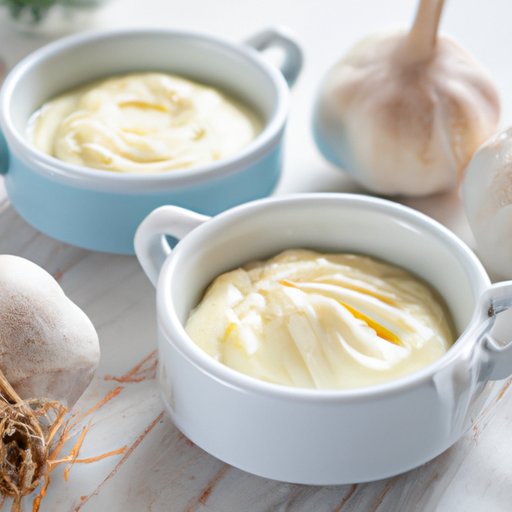
I. Introduction
Garlic aioli is a classic Mediterranean dip that adds flavor to any dish. Made with garlic, egg yolk, lemon juice, and olive oil, it’s a versatile condiment that pairs well with everything from french fries to seafood.
In this article, we’ll provide a step-by-step recipe for making garlic aioli from scratch as well as explore the history of the popular sauce, variation options, serving suggestions, and nutritional information. Whether you’re an experienced cook or a beginner, this article will help you master the art of making the best garlic aioli.
II. Step-by-Step Recipe Approach
To make garlic aioli, you will need the following ingredients:
- 2 garlic cloves, finely minced
- 1/4 teaspoon salt
- 1 egg yolk
- 1 tablespoon fresh lemon juice
- 1/2 cup extra-virgin olive oil
Here’s how to make garlic aioli:
- In a medium mixing bowl, combine the minced garlic and salt.
- Add the egg yolk and lemon juice to the garlic mixture.
- Using a whisk or a hand mixer, beat the mixture for 1-2 minutes until the ingredients are well combined.
- While continuing to mix the ingredients, slowly add the olive oil to the bowl in a thin, steady stream.
- Continue to beat the mixture until the aioli thickens and emulsifies, which should take about 5 minutes.
- Adjust the seasoning to taste, adding more salt or lemon juice if desired.
Once the garlic aioli has been prepared, it’s important to properly store it. Place the dip in a sealed container and refrigerate for up to 5 days. Never leave the garlic aioli out at room temperature for more than two hours, as this can create a risk of foodborne illness.
III. Historical Context
Garlic aioli originated in the Provence region of France and is considered a staple in Mediterranean cuisine. Traditionally, aioli was made by pounding garlic into a paste with a mortar and pestle and then whisking it together with olive oil until it emulsified.
In the past, aioli was served as a sauce for fish, shellfish, and crudités, but over time it has become a popular condiment for a variety of dishes. Today, many chefs also add other flavors and ingredients to create unique variations that complement different foods and flavors.
IV. Variations and Substitutions
While garlic aioli is already a delicious dip on its own, there are many variations and substitutions that can add new flavors and textures to the sauce. Here are a few variations to try:
- Avocado aioli: Replace half the olive oil with mashed avocado for a creamier dip.
- Smoked paprika aioli: Add a teaspoon of smoked paprika to the recipe for a smoky twist on traditional garlic aioli.
- Pesto aioli: Mix in some homemade pesto to create a fresh, herbaceous sauce.
In addition to these variations, you can also substitute some of the ingredients to make garlic aioli suit your dietary needs. For example, you can use vegan mayonnaise instead of egg yolk if you’re making a vegan dip or use lime juice instead of lemon juice for a unique citrus twist.
V. Pairing and Serving Suggestions
Garlic aioli is a versatile dip that can be used in many different ways. Here are some serving and pairing suggestions:
- Serve with roasted vegetables or as a dip for bread and crackers.
- Use as a sauce for fish, seafood, and chicken dishes.
- Spread garlic aioli on sandwiches and burgers instead of mayonnaise.
- Use as a dipping sauce for french fries or sweet potato fries.
When pairing garlic aioli with foods, it’s important to consider the flavors and textures of the dishes you’re serving. Garlic aioli has a strong garlic taste, so it pairs well with savory dishes that have bold flavors like red meat, grilled vegetables, and seafood.
VI. Nutritional Value
Garlic aioli may not be the healthiest dip out there, but it does offer some nutritional benefits. Here are a few:
- Garlic contains allicin, a compound that has been shown to have antibacterial and antiviral properties.
- Olive oil, which is used in the recipe, is high in monounsaturated fatty acids that can help reduce your risk of heart disease.
- Garlic aioli is a good source of healthy fats, which can keep you feeling full and satisfied.
However, it’s important to enjoy garlic aioli in moderation, as it’s high in calories and fat. One ounce of garlic aioli contains about 120 calories and 12 grams of fat.
VII. FAQ and Troubleshooting
If you’re new to making aioli, you might run into some problems along the way. Here are some common FAQs and troubleshooting tips to help you achieve the perfect garlic aioli:
- Q: Why is my aioli not emulsifying?
- A: The key to making aioli is slow and steady mixing. If you add the oil too quickly, the sauce will not emulsify properly.
- Q: How can I avoid my garlic aioli from curdling?
- A: Always use the freshest eggs possible and make sure all of the ingredients are at room temperature. You can also add a tablespoon of warm water to the mixture to help prevent curdling.
VIII. Conclusion
Garlic aioli is a flavorful sauce that adds a punch to any dish. Using this article as your guide, you can now make garlic aioli with confidence and experiment with variations that suit your tastes. Whether you’re enjoying it as a dip or a sauce, garlic aioli is a must-have in every kitchen.
If you’re interested in exploring more recipes and dips in the Mediterranean cuisine, check out our website for more ideas and resources.





